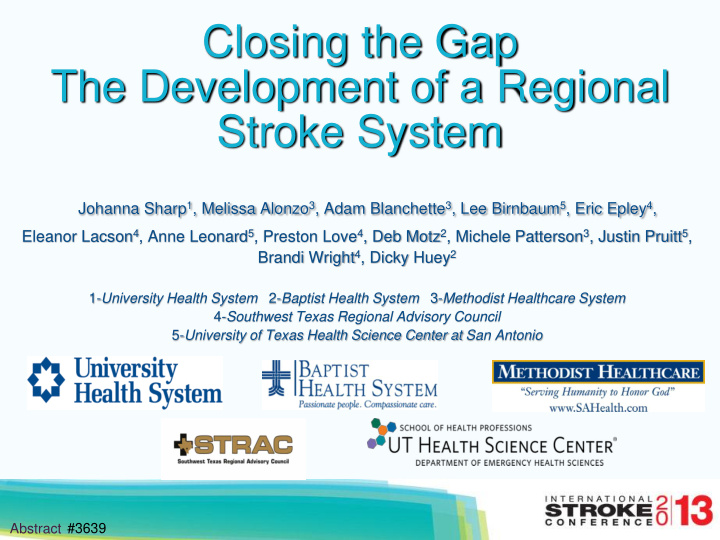



Closing the Gap The Development of a Regional Stroke System Johanna Sharp 1 , Melissa Alonzo 3 , Adam Blanchette 3 , Lee Birnbaum 5 , Eric Epley 4 , Eleanor Lacson 4 , Anne Leonard 5 , Preston Love 4 , Deb Motz 2 , Michele Patterson 3 , Justin Pruitt 5 , Brandi Wright 4 , Dicky Huey 2 1- University Health System 2- Baptist Health System 3- Methodist Healthcare System 4- Southwest Texas Regional Advisory Council 5- University of Texas Health Science Center at San Antonio Abstract #3639
Background and Purpose • In 2009, the 7 th largest Texas Trauma Service Areas populated city in the United States, had no certified Primary Stroke Centers, or organized approach to care for stroke patients. The purpose is to describe how in one year, a large geographic region progressed from no system of stroke care to an organized system of 10 Certified Primary Stroke Centers and numerous EMS agencies.
Methods Hospital leaders were compelled to create stroke programs in their facilities in response to intense community pressure following a patient who had a poor outcome secondary to no access to a stroke center in San Antonio. The Southwest Texas Regional Advisory Council (STRAC) Stroke Committee, comprised of hospital, physician and EMS leaders developed a Stroke Letter of Attestation signed by participating hospitals and EMS agencies. This letter defined an interim process for performance and pre-hospital stroke alert criteria while hospitals developed programs and became certified as stroke centers.
Methods Despite a competitive environment, Stroke Coordinators met monthly to discuss data and develop regional reports for review in the Stroke Committee. In addition, stroke algorithms were distributed to rural facilities to assist with care prior to transfer to a stroke center .
Methods The agreement established a commitment to maintain rapid response teams, a central one-call transfer process, and process improvement. Transfer tracking sheets were developed to monitor hospital responses to transfer requests and patient acceptance.
Results Stroke Patients Transferred Out of TSA-P CY 2009-2012* 13 14 12 Patients 10 8 8 6 2 4 1 2 0 2009 2010 2011 2012 " STROKE Patients " is defined as any patient transported by AirLIFE from within Trauma Service Area - P that had a transferring diagnosis with any of the following: Cerebral Vascular Accident, Stroke, Subarachnoid Hemorrhage, or Intracranial Hemorrhage " STROKE Patients Transported Out of Region " is defined as any patient that was defined as a Data Provided by San Antonio AirLIFE By coordinating a system of care with first responders, no longer diverting patients out of the service area, and data sharing, a large region progressed from having no stroke system to an organized system of 10 Certified Primary Stroke Centers, which provide the region access to quality care. The STRAC Stroke/Performance Improvement Committee and Coordinator Committee continue monthly meetings.
Results
Conclusion This process successfully closed the gap in stroke care. The STRAC Stroke Committee continues to improve data collection, provide feedback to EMS, set goals for public education, and engage hospitals and EMS agencies in the commitment to quality stroke care.
Recommend
More recommend